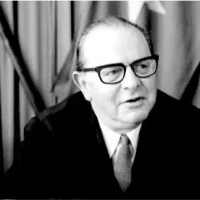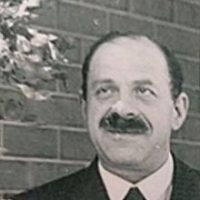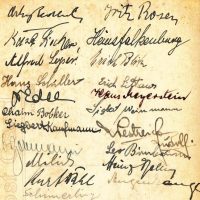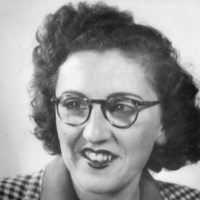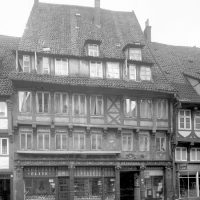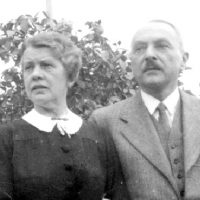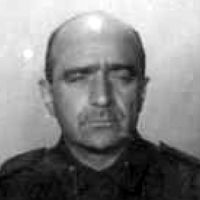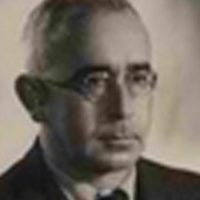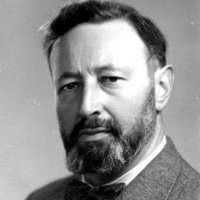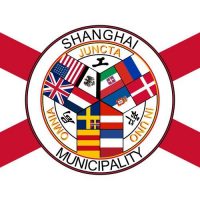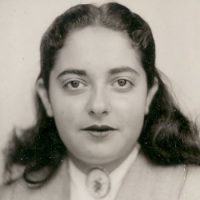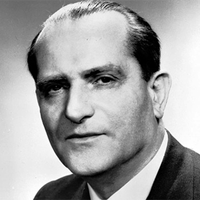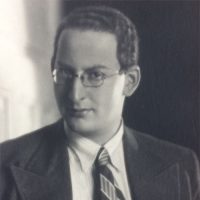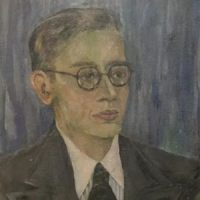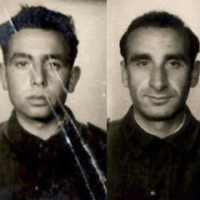Ida Dehn had always spoken of friends of her father with whose help she – as the only one of her own family – escaped the Nazi terror. In this context, the name Nussbaum may have come up, which was later confirmed by research. It is to the Nussbaum family – the parents Levy Leo and Mally and their daughters Jutta and Marga – that the Dehn family owes the rescue of their mother and grandmother Ida, and thus basically their very existence. The Nussbaums took Ida, then 17 years old, on a trip to Australia at the end of 1938. In the family narrative, the shared trail disappears upon arrival in Melbourne. A chance discovery on Facebook led to contact with grandchildren of the Nussbaums in Australia. Supplementary information was found in a doctor’s thesis on reparations in Hanover.
Peter Dehn, January 2024.
A world trip into survival
The Nussbaums come from Hesse. Meier (Moritz) Nussbaum[1] Civil registry Hersfeld, entry no. 149 of July 17, 1919 is born in Erdmannrode (Hesse) on August 10, 1838; he is the son of Salomon and his wife Sara née Wertheim. He dies in Hersfeld[2] Wikipedia about Hersfeld (Bad Hersfeld since 1949), retrieved 15 May, 2023. on July 16, 1919.
On December 10, 1878 the widowed Meier marries Bertha Stern[3] Civil registry entry no. 9 of December 10, 1878.. She is born on December 19, 1850 in Beiseförth. The young couple settled in Hersfeld/Hesse. The third of their seven children is Levi[4] For the first name there is also the spelling "Levy". From when and how "Leo" became official as a call name is not known. "Leo" is used here in the further. (Leo), who sees the light of day there on September 1, 1883[5] Civil registry Hersfeld entry no. 174 of September 6, 1883..
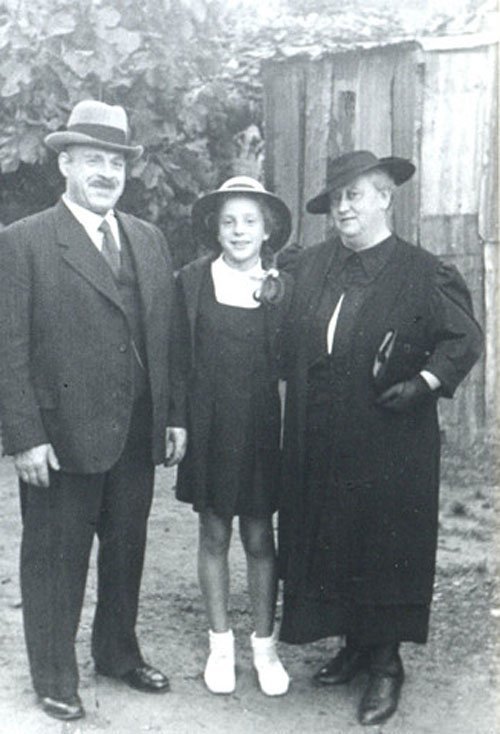
Leo, Jutta and Malli Nussbaum. Source: geni.com.
On August 30, 1912[6] Civil registry entry Felsberg no. 6 of August 30, 1912. he marries Mally[7] Civil registry entry Felsberg no. 17 of June 30, 1887., the daughter of the horse dealer Isaak Marx and his wife Jettchen Loewenstein, born on June 29, 1887, at her birthplace Felsberg/Hesse. Their children Herbert (* September 24, 1913), Marga (* April 15, 1921) and Jutta (* September 25, 1930) born in Hanover.
Kosher butcher shop in the center of Hannover
At the time of the wedding, Leo, by now a master butcher, was already living in Hanover. Entries in address books there, however, are not found until 1920: He is listed with his occupation at Nordmannstrasse 15[8] Address Book Hanover 1920, page 295. and as the tenant of the ground floor and first floor – i.e. certainly the store and apartment. From 1928, he is also listed as the owner[9] Address Book Hanover 1928, page 181. of the building. The address is in the busy center of the city between the between the main train station and Steintor[10] Due to the destruction of the war, the center of Hanover was redesigned; Nordmannstrasse fell victim to this..
The Flieder family lives with their daughter Ida[11] Civil registry birth entry Hanover no.2053 of June 27, 1921. at Marktstraße 38. Her father Abraham (Adam) can no longer practice his profession as a brush maker for health reasons. After finishing school – from September 1, 1936 – Abraham sends his 15 year old daughter to the Nussbaum family, whom he knows, in Nordmannstrasse[12] Registration card Hanover for Flieder family, Dehn family archives., barely 10 minutes away on foot. She becomes a domestic helper for the Nussbaums. She is thus provided for, perhaps earns some money of her own and is not a burden on her parents. Both sides benefited from the fact that Ida Flieder and Marga Nussbaum were the same age. Did Ida and Marga already know each other from a time they spent together, e.g. in the Jewish kindergarten at Ohestraße 9 or at the elementary school?
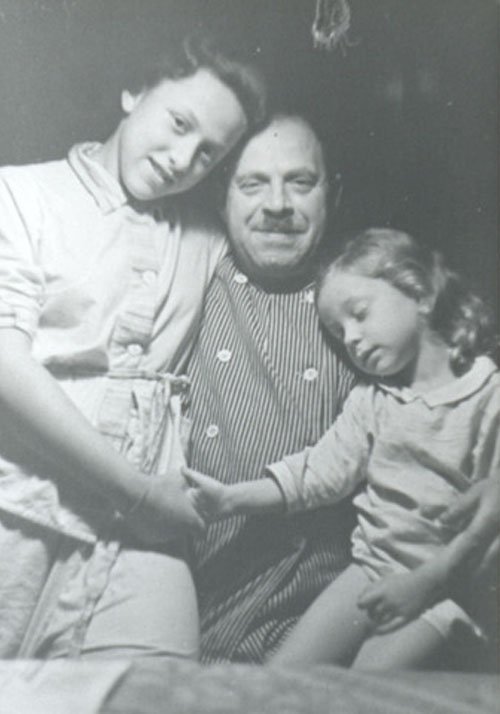
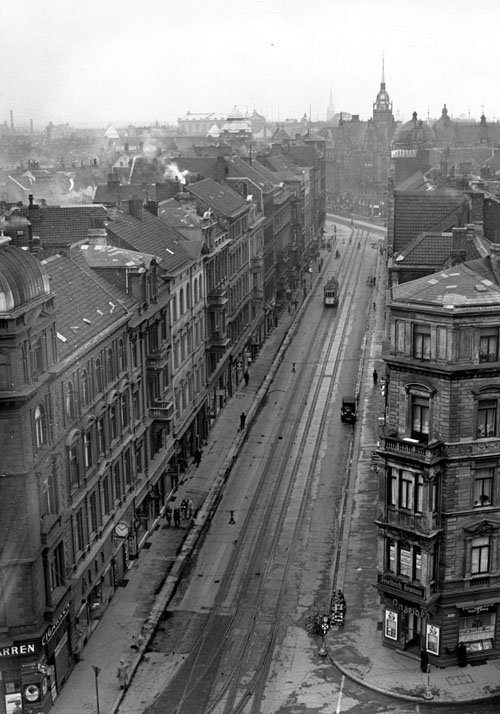
Persecuted by the Nazis
Both families are exposed to the persecutions of the Nazis. The Nazis had taken Ida’s father Abraham and her younger brother Isaak to the East in the course of the so-called 1st “Polenaktion” at the end of October 1938 together with thousands of other Jews of Polish origin and had taken them out of the railroad wagons at the border to Poland and pushed them into Poland.
Leo Nussbaum is one of tens of thousands of Jews who were deported to concentration camps without cause immediately after the Pogrom Night on November 9, 1938. Nussbaum’s butcher shop is destroyed by SA rioters[13] The destruction is confirmed by a note from the Hanover compensation authority dated 5.11.1956. Lower Saxony State Archives (NLA) HStAH Nds. 110 W Acc.14/99 No. 110162 Bl. 140. Quoted from Florian Grumblies "Rückerstattung und Entschädigung. Die Praxis der 'Wiedergutmachung' nationalsozialistischen Unrechts am Beispiel der Juden der Stadt Hannover 1945 - 1965" (Dissertation 2021), page 633. during this night of the Nazi terror and the delivery truck[14] Grumblies loc.cit., page 218. is stolen without legal basis, so that the family’s livelihood is taken away. In Hanover[15] Juden in Hannover: Geschichte und Gegenwart“ (German), Haus der Religionen, retrieved Sep 20, 2023. alone, 94 stores and 27 apartments were plundered. Leo, like thousands of Jewish men – including 316 from the Leine city -, is arrested shortly afterwards and held in the Buchenwald concentration camp[16] Change notification from November 14, 1938, Arolsen Archives. The men are forced to buy their freedom with the promise to leave Germany more or less immediately. As the family reports, it was Marga who went to Gestapo[17] Mark Rubinstein to Peter Dehn, email of Sep 29, 2023. headquarters and negotiated her father’s release. Within two weeks the family had to leave the country.
Leo Nussbaum had foreseen that a normal life would be made impossible for Jews in Germany under Nazi rule. He made contact with Australia. Already on July 20, 1938, Norman Smorgon[18] National Archives of Australia (NAA), NAA_ItemNumber8209899. By the end of the 20th century, the Smorgons are the richest family in Australia cf. Wikipedia , retrieved May 15, 2023. applied there for the Nussbaums’ entry and vouched for them. His company Norman Smorgon & Sons had been founded 1927 by three Jewish brothers who had emigrated from the Soviet Union shaken by civil war. In Melbourne, after only ten years, they already have a name. Slaughtering and leather processing were soon joined by the production of canned meat, and the trading and export of meat products. As the Nussbaum grandson Mark Rubinstein notes, Smorgon only granted the guarantee[19] Mark Rubinstein to Peter Dehn, email of April 21, 2023. because Leo Nussbaum promises not to compete with him.
The trip to Australia
The four Nussbaums and Ida Flieder begin their journey to Melbourne on December 12, 1938. Ida’s Hanover registration card[20] Registration card Hanover, family archives Dehn. confirms this date with the notation “unbek.” (unknown). The long journey[21] Grumblies loc.cit., page 688. begins by train to Hamburg[22] Detailed account in the letter from Heinz Dehn to RA Eckstein of March 13, 1957; Dehn family archives., where Australia’s consulate general[23] Visum Ida Dehn see NAA_ItemNumber7249875. issues visas on December 19, 1938. Arrival at the port of Grimsby on the British North Sea coast is followed by a rail transfer and stopover in Liverpool.
The next leg leads across the Atlantic to Halifax/Canada[24] The foreign arrival index for the Nussbaums and Ida Flieder in Canada uses three metrics - age - likely cabin - and year of arrival. on December 31, 1938; they celebrate the New Year on the Duchess of Atholl. Consecutive ticket numbers and official notes of arrival for the Nussbaums and Ida suggest a shared cabin, probably number 7. Ida Flieder is listed as “domestic[25] Passenger list Duchess of Atholl from Liverpool to Halifax of December 31, 1938, Dehn family archive.” in the passenger list.
From the Atlantic coast, the family travels by rail across Canada to the Pacific Ocean at Vancouver. There, the departure of the MS Aorangi on January 19, 1939 is awaited. The largest and fastest motor ship in the world when it entered service in 1925 makes intermediate stops in Honolulu (January 25), Suva (February 2) and Auckland (February 5). It reached Sydney on February 10, 1939, where the five refugees from Hanover disembarked. The files of the MS Aorangi show that the Nussbaums and Ida Flieder have consecutive ticket numbers for a shared cabin on this ship as well. They reach their destination Melbourne[26] Australian questionaires of the Nussbaum family (NAA_ItemNumber8209899) and Ida Flieder (NAA_ItemNumber7249875) of February 10, 1939. on February 12, 1939. Their first joint residential address is house number 1 on Waterloo Street[27] Nussbaum and Flieder files of the Australia Jewish Welfare and Relief Society. US Holocaust Memorial Museums, retrieved March 5, 2023. (today Waterloo Crescent) in the St. Kilda district favored by Jews.
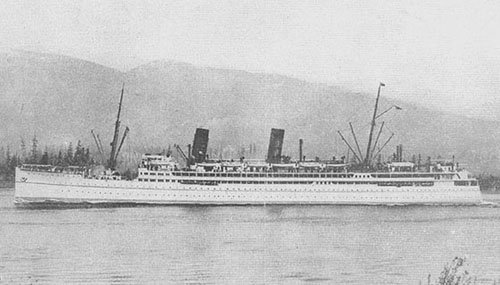
Great-grandson Mark Rubinstein has childhood memories[28] Mark Rubinstein to Peter Dehn, loc.cit. of his grandfather: “He made jumping jacks out of pieces of lumber to entertain me.” The Nussbaum parents lived there[29] See electoral lists via www.ancestry.de. at least until Leo died on April 23, 1958[30] Family announcement in „Aufbau“ of June 6,1958, page 33; Dehn family archive.. He fell asleep peacefully, daughter Jutta tells her children. “Although he had colon cancer, he died because of a wrong blood transfusion”, Mark adds. Mally Nussbaum[31] See entry on Jewish Gen. dies in Melbourne on March 14, 1967.
Children and children’s children of the Nussbaums

Herbert (“Selli”) Nussbaum is the oldest child of Leo and Mally Nussbaum. He was born on September 24, 1913. To escape persecution, he studies law in Geneva, among other places, where he finances his studies as a photographer. He leaves for Southampton via Bremen on March 2, 1937. From there, “Herbert Nussbaum, Photographer” travels to South Africa[32] Passenger list Stirling Castle of March 5, 937. on the Stirling Castle from March 5. There he serves in the army during the war. Afterwards he works as a press and freelance photographer in Johannesburg. He is married to Paula Fuchs[33] Family tree Paula Nussbaum, retrieved May 15, 2023. (née Adler, 10 August.1921, Poland, died 31 May 2009 in South Africa). They have two children; the marriage is divorced in 1957. Herbert Nussbaum[34] Family tree Herbert Nussbaum, retrieved May 15, 2023. dies in Johannesburg on December 12, 1997.
Marga, the elder daughter of the Nussbaums, is born in Hanover on April 15, 1921. Soon after arriving in Australia, she travelled to South Africa, where she married Leonhard Cronheim[35] Mark Rubinstein an Peter Dehn, Mail vom 26.3.2024. in 1939. The marriage did not last long. She had a second marriage with Peter Baum, with whom she had a daughter. They lived for a time in Liberia, where Marga worked for the diamond dealer de Beers. Peter dies in the 1960s. She marries in third marriage Karlheinz Meyer (1930-2018). She dies on May 6, 2015 in Bendestorf[36] Ibid. near Hamburg, where she and her husband lived for decades.
Her sister Jutta, born in Hanover on September 25, 1930, and almost nine years younger, stays with her parents in Melbourne. After completing 10th grade, she learns shorthand, typing and tailoring. In 1951, only 20 years old, she marries Isaac (“Issy”) Rubinstein, whom she has known since she was 14. In addition to her work, Jutta manages the household. Her five children are soon joined by her mother Malli, who suffers from a stroke, out-of-town students “and a veritable menagerie of cats, dogs, a turkey and other animals”. By 1969, Jutta is working successfully as a real estate agent[37] Ibid.. Issy dies in 2006, and Jutta passes away in Melbourne on June 12, 2020. She is survived by five children, 17 grandchildren and two great-grandchildren.
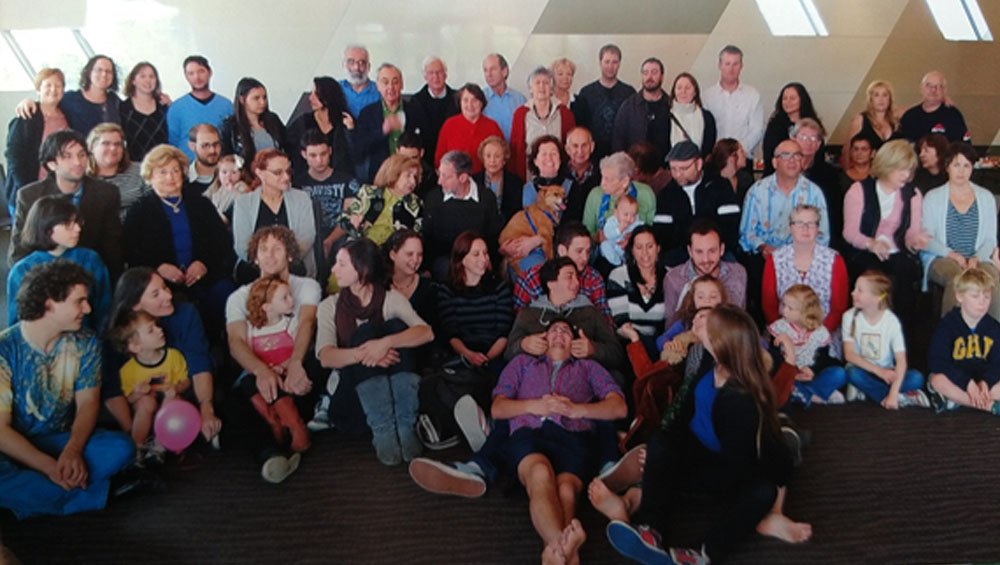
“Compensation”: chicanery and a blind butcher
For his thesis about restitution and compensation to Jews of Hanover Dr Florian Grumblies extensively researched documents on the compensation procedures of Hanoverian Jews. From the files of the Nussbaum family, he refers several times to typical harassment by the authorities against Jewish applicants. For example, a court is looking for witnesses to have the property and assets declared by the Nussbaums confirmed. Among other things, the testimony of a married couple[38] A Philipp Martin ran a butcher shop at Nordmannstrasse 5 at that time. who had operated a butcher’s shop near Nordmannstrasse 15 is included in the verdict. Quite blatantly, these people state for the record that Nussbaum’s store had not been “subjected to boycott measures”. The fact that the destruction of the store, ten house numbers away, and the media jubilation about “Kristallnacht” remained unknown to Mr. Fleischer was apparently believed only by Federal German authorities at the time.
The butcher, whose competitor had got rid of by the Nazis, further claimed that the turnover of the Nussbaum butcher’s store had been insignificant even before 1933, because it was “a decidedly Jewish store where not everyone bought”. It was a “larger, not very appealing store with insignificant customer traffic.“ This was recorded by the Ordnungsamt Hannover on April 26, 1956, on behalf of the compensation authority. In this way, not only the damage caused by the Nazis is minimized. As a consequence, the persecution of Jews is denied. The compensation authority accepts this without objection[39] Grumblies loc.cit., page 630. and ignores the information of the victims!
Grumblies judges the treatment of Leo Nussbaum’s application for reimbursement of his escape expenses to Australia[40] Grumblies loc.cit, Seite 688 f. to be exemplary of many proceedings for “reparation”. As part of his expenses of around 600 British pounds, Leo Nussbaum puts the ship voyages at 300 pounds. The Hanover compensation authority is now not examining what costs were actually spent on the journeys with ships of the New Zealand and Canadian shipping company involved in the trip. Rather, the payment is pressed with the remark that the German shipping company Hapag (which was not involved at all) would have charged 55 pounds per adult and half of that for children up to 12 years of age for such a trip in 1938.
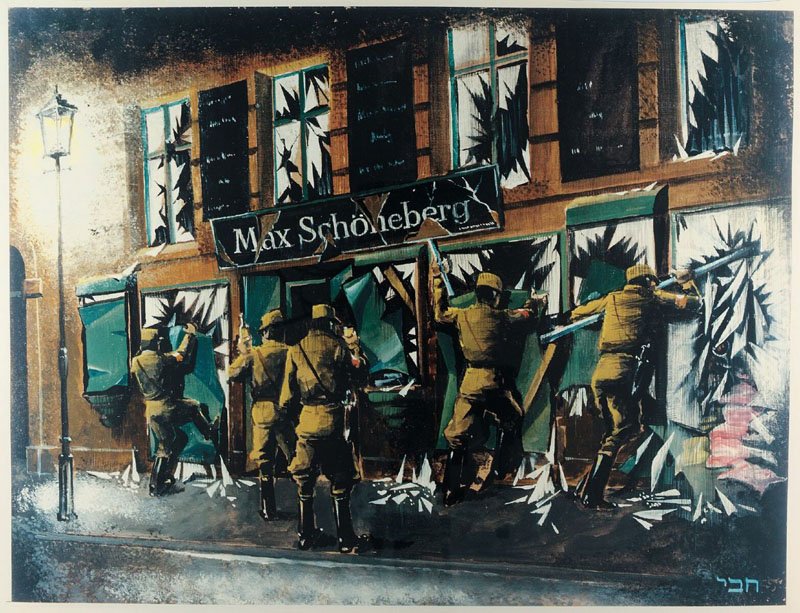
“No boycott measures …”? Dunera Boy Hans Hermann Josephy (Hans Jackson) painted his memory of the pogrom in his street in Berlin. Courtesy of Allen Sternstein.
The compensation for the trip, however, is calculated quite differently: The Nazi finance authority had granted the Nussbaums 10,046.70 Reichsmark from their own assets (!) for the trip, which did not have to be paid to the Nazi state. This amount was converted by the compensation authority 10:2 to Deutsche Mark, so that only 2,009.34 DM had to be reimbursed. In this case, too, the theft of Jewish property (and its legal dressing up) by the Nazis is indirectly legitimized.
Incidentally, all compensation offices at that time consulted documents of the tax authorities (including the chief tax offices) for their decisions. These authorities maintained collection points for the profits from stolen Jewish property during the Nazi era. However, by law, the affected claimants are denied access to these records. Instead, they must individually list the monetary values of spoliated property, home furnishings, jewelry, etc., and credibly value them. Leo Nussbaum is generously offered 1,300 DM. He does not live long enough to see this offer of a “settlement”. His widow was not awarded 1,604 DM for freight and customs costs until 1963 – and after an elaborate Australian-German inheritance certificate procedure.
Please note: Various sources, especially for redress, write the family name with “ss”, others with “ß”. Here (except in quotations) the spelling “Nussbaum” is used.
Footnotes
show
- [1]↑Civil registry Hersfeld, entry no. 149 of July 17, 1919
- [2]↑Wikipedia about Hersfeld (Bad Hersfeld since 1949), retrieved 15 May, 2023.
- [3]↑Civil registry entry no. 9 of December 10, 1878.
- [4]↑For the first name there is also the spelling "Levy". From when and how "Leo" became official as a call name is not known. "Leo" is used here in the further.
- [5]↑Civil registry Hersfeld entry no. 174 of September 6, 1883.
- [6]↑Civil registry entry Felsberg no. 6 of August 30, 1912.
- [7]↑Civil registry entry Felsberg no. 17 of June 30, 1887.
- [8]↑Address Book Hanover 1920, page 295.
- [9]↑Address Book Hanover 1928, page 181.
- [10]↑Due to the destruction of the war, the center of Hanover was redesigned; Nordmannstrasse fell victim to this.
- [11]↑Civil registry birth entry Hanover no.2053 of June 27, 1921.
- [12]↑Registration card Hanover for Flieder family, Dehn family archives.
- [13]↑The destruction is confirmed by a note from the Hanover compensation authority dated 5.11.1956. Lower Saxony State Archives (NLA) HStAH Nds. 110 W Acc.14/99 No. 110162 Bl. 140. Quoted from Florian Grumblies "Rückerstattung und Entschädigung. Die Praxis der 'Wiedergutmachung' nationalsozialistischen Unrechts am Beispiel der Juden der Stadt Hannover 1945 - 1965" (Dissertation 2021), page 633.
- [14]↑Grumblies loc.cit., page 218.
- [15]↑Juden in Hannover: Geschichte und Gegenwart“ (German), Haus der Religionen, retrieved Sep 20, 2023.
- [16]↑Change notification from November 14, 1938, Arolsen Archives.
- [17]↑Mark Rubinstein to Peter Dehn, email of Sep 29, 2023.
- [18]↑National Archives of Australia (NAA), NAA_ItemNumber8209899. By the end of the 20th century, the Smorgons are the richest family in Australia cf. Wikipedia , retrieved May 15, 2023.
- [19]↑Mark Rubinstein to Peter Dehn, email of April 21, 2023.
- [20]↑Registration card Hanover, family archives Dehn.
- [21]↑Grumblies loc.cit., page 688.
- [22]↑Detailed account in the letter from Heinz Dehn to RA Eckstein of March 13, 1957; Dehn family archives.
- [23]↑Visum Ida Dehn see NAA_ItemNumber7249875.
- [24]↑The foreign arrival index for the Nussbaums and Ida Flieder in Canada uses three metrics - age - likely cabin - and year of arrival.
- [25]↑Passenger list Duchess of Atholl from Liverpool to Halifax of December 31, 1938, Dehn family archive.
- [26]↑Australian questionaires of the Nussbaum family (NAA_ItemNumber8209899) and Ida Flieder (NAA_ItemNumber7249875) of February 10, 1939.
- [27]↑Nussbaum and Flieder files of the Australia Jewish Welfare and Relief Society. US Holocaust Memorial Museums, retrieved March 5, 2023.
- [28]↑Mark Rubinstein to Peter Dehn, loc.cit.
- [29]↑See electoral lists via www.ancestry.de.
- [30]↑Family announcement in „Aufbau“ of June 6,1958, page 33; Dehn family archive.
- [31]↑See entry on Jewish Gen.
- [32]↑Passenger list Stirling Castle of March 5, 937.
- [33]↑Family tree Paula Nussbaum, retrieved May 15, 2023.
- [34]↑Family tree Herbert Nussbaum, retrieved May 15, 2023.
- [35]↑Mark Rubinstein an Peter Dehn, Mail vom 26.3.2024.
- [36]↑Ibid.
- [37]↑Ibid.
- [38]↑A Philipp Martin ran a butcher shop at Nordmannstrasse 5 at that time.
- [39]↑Grumblies loc.cit., page 630.
- [40]↑Grumblies loc.cit, Seite 688 f.
